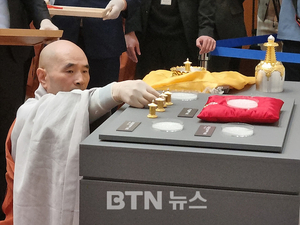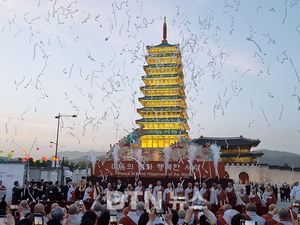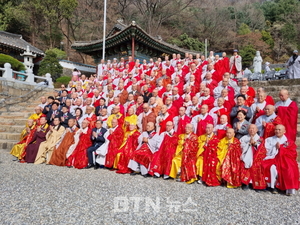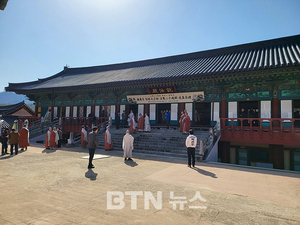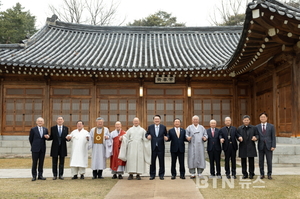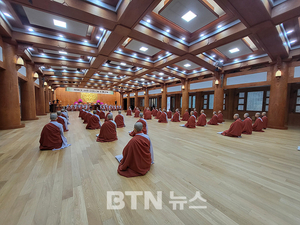- 시위의 역사적 한 형태‥분신은 해결책이 아니다 비판도
[부디스트채널, A Tibetan Monk Goes Up in Flames. Who's to Blame?, by Hannah Beech, Time, August 16, 2011]
티벳 순교자 기념관은 다람살라에 위치한 방첨탑인데, 중국인 통치하의 고국을 떠난 망명 티벳인들의 본부로 사용되는 인도의 고원 피서지이다.
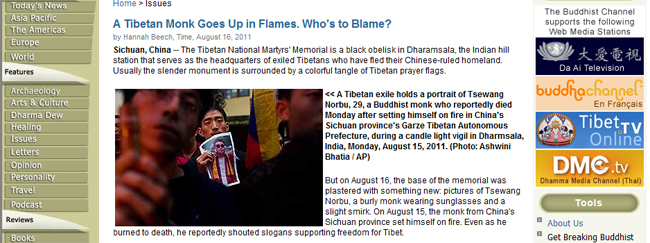 △한 티벳 망명객이 29살의 스님 체왕 노르부의 초상화를 들고 있다. 보도에 따르면, 그는 8월 15일 중국의 쓰촨 지방의 티벳 자치구에서 자신의 몸에 불을 지른 후 사망한 것으로 알려졌다. 사진=부디스트채널 |
이번 분신은 쓰촨의 한 티벳 스님 을 포함해 올해로 두 번째다. 티벳 망명자 단체에 의하면, 두 스님 모두 중국의 소수 민족과 종교적 표현에 대한 높아지는 탄압 때문에 필사적이었다고 한다.(중국 관영의 신화통신사는 체왕 노르부가 몸에 불을 지른 것은 인정했으나 당국은 왜 29살의 그가 그렇게 했는지는 알지 못한다고 보도했다.)
분명히 그 두 스님이 살았던 사찰에 대한 공식적 반응은 재빠르고 가혹했다. 풍트소그라는 이름의 스님이 3월 자신의 몸에 기름을 끼얹고 난 후 키르티 사원에 있는 수백 명의 그의 동료 스님들은 강제로 떠나야했다. 티벳 미디어에 따르면, 감시가 현재까지도 이어지고 있다. 망명자 단체들은 비슷한 사건들이 체왕 노르부의 닛소사에서 계속되고 있으며, 중국 공안부대들은 그 사찰을 에워싸고 있다고 전했다.
7월, 그 사찰은 다람살라에서 망명객으로 살고 있는 티벳의 영적 지도자 달라이 라마의 76번째 생일을 축하하려고 함으로써 중국정부의 금지에 도전했었다. 베이징은 달라이 라마를 위험한 분리론자로 여기고 있다. 중국에서는 단지 그의 사진을 전시하는 것만으로도 심각한 파문을 일으킬 수 있다. 최근에 닛소사는 대담하게 달라이 라마를 존경함으로써 체왕 노르부가 자신의 몸에 불을 붙이는 화약고와 같은 분위기를 만든 것으로 인해 사실상 경찰의 포위하에 있다고 그 지역과 관계를 맺고 있는 망명 스님들은 전한다. 그의 분신이 있기 바로 전, 그는 티벳의 자유를 요구하고 달라이 라마를 찬양하는 인쇄물을 배포했다.
1980년대부터 달라이 라마는 그가 티벳의 완전한 독립이 아닌 자치권을 요구한다고 주장해왔다. 그는 무자비한 중국의 지배에 대한 비폭력적 저항을 옹호함으로 노벨 평화상을 수상했다. 그러나 몇몇의 사건들에 대해 티벳인들 사이에 실망이 끓어올랐는데, 가장 최근인 2008년에는 티벳과 중국의 한족 사이에 시위대의 치명적인 충돌로 절정에 이르렀다. 한족은 최근에 티벳으로 몰려들었고, 티벳인들은 최근 중국정부의 티벳에 대한 적극적 투자로 창출된 좋은 직업들의 대부분을 한족이 차지하고 있다고 주장한다.
그 스님의 격렬한 표현은 중국이 티벳의 광대한 지역에 도로와 기타 개발 계획을 세움에도 불구하고, 티벳인들의 불만족이 얼마나 깊게 남아있는지에 대한 또 다른 신호이다. 비록 분신이 베트남과 같은 곳에서 스님들에 의한 시위의 역사적인 한 형태이지만, 현대 티벳 불교에서 그것은 전통이 아니다. 일부 다람살라의 티벳인들은 체왕 노르부를 순교자로 애도하는 반면, 또 다른 일각에서는 그를 용서하지 않고 있다. “자살은 우리의 가르침에 반하는 것이다”라고 다람살라에서 수행중인 한 스님은 말하면서, 티벳으로 돌아갈 계획이기 때문에 자신의 이름을 밝히기를 거절했다. “우리는 모두 필사적이다, 그러나 분신은 해결책이 아니다.”
번역=하경목 기자
[원문 보기 http://www.buddhistchannel.tv/index.php?id=70,10393,0,0,1,0]
A Tibetan Monk Goes Up in Flames. Who's to Blame?
by Hannah Beech, Time, August 16, 2011
Sichuan, China -- The Tibetan National Martyrs' Memorial is a black obelisk in Dharamsala, the Indian hill station that serves as the headquarters of exiled Tibetans who have fled their Chinese-ruled homeland. Usually the slender monument is surrounded by a colorful tangle of Tibetan prayer flags.
But on August 16, the base of the memorial was plastered with something new: pictures of Tsewang Norbu, a burly monk wearing sunglasses and a slight smirk. On August 15, the monk from China's Sichuan province set himself on fire. Even as he burned to death, he reportedly shouted slogans supporting freedom for Tibet.
The self-immolation was the second this year by a Tibetan monk in Sichuan. Both clerics, according to exile Tibetan organizations, were driven to desperation by a mounting Chinese crackdown on ethnic minorities and religious expression. (China's official Xinhua News Agency acknowledged that Tsewang Norbu's set himself ablaze but reported that authorities did not know why the 29-year-old had done so.)
Certainly the official reaction toward the monasteries where the two monks lived was swift and harsh. After a monk named Phuntsog fatally doused himself with fuel in March, hundreds of his fellow monks at the Kirti monastery were forced to leave; surveillance continues to this day, according to Tibetan media. Exile groups report that similar events are now unfolding at Tsewang Norbu's Nyitso monastery, where Chinese security forces are ringing the complex and telecommunications have been severed.
In July, the monastery had defied a government ban by trying to celebrate the 76th birthday of the Dalai Lama, the Tibetan spiritual leader who lives in exile in Dharamsala. Beijing considers the Dalai Lama to be a dangerous secessionist; simply displaying his image can carry heavy repercussions in China. In recent days, Nyitso monastery was essentially under police siege for having dared to venerate the Dalai Lama, say exiled monks with ties to the area, leading to the tinderbox atmosphere in which Tsewang Norbu lit himself on fire. Shortly before his self-immolation, the monk apparently passed out leaflets calling for Tibetan freedom and praising the Dalai Lama.
Since the 1980s, the Dalai Lama has insisted that he is calling for autonomy for Tibet, not outright independence. He has won the Nobel Peace Prize for advocating non-violent resistance against a brutal Chinese rule. But frustration among Tibetans has boiled over on several occasions, most recently in 2008 when protests culminated in deadly clashes between Tibetans and members of China's Han majority. The latter ethnic group has flooded to Tibet in recent years, and Tibetans allege the Han get most of the good jobs created by China's recent investment drive in Tibet.
The monks' fiery displays are just another sign of how deep Tibetan discontent remains, even as China builds roads and other development projects across the vast region. Although self-immolation was a historic mode of protest by monks in places like Vietnam, it is not a tradition in modern Tibetan Buddhism. So while some Tibetans in Dharamsala mourned Tsewang Norbu as a martyr, others were less forgiving. “Committing suicide is against our teachings,” says a monk studying in Dharamsala, who declined to give his name because he plans to return to Tibet. “We are all desperate, but [suicide] is not the solution.”
하경목 btnnews@btn.co.kr


